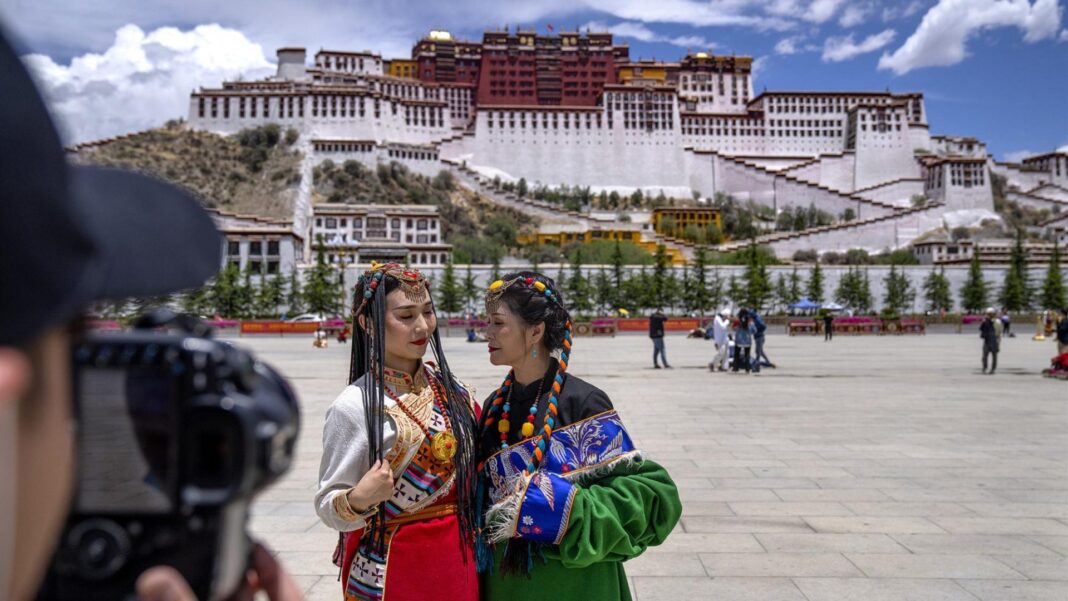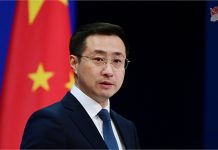BEIJING: China has achieved major targets in Cultural and Tourism Industry during 2022, a year marked by Annual Stocktaking Report on China’s Cultural Industry and Tourism as a ‘tough year’.
I. Development overview of China’s cultural industry and tourism in 2022
In 2022, China’s cultural industry and tourism have experienced internal and external difficulties under the complex conditions. First, in terms of policies, industry relief policies and regional planning opinions were intensively introduced. Under the continued impact of the epidemic, the combination of relief policies for the cultural tourism industry, represented by the Several Policies on Promoting the Recovery of Difficult Industries in the Service Sector and the Notice on Expanding the Implementation Scope of the Policy of Phased Deferment of Social Insurance Premiums and Other Issues, has been put in force at many levels, including taxation, finance and employment, to boost the recovery of the cultural tourism market.
Meanwhile, among the 45 important policies issued by the national ministry of culture and tourism in 2022, the planning opinions and guidances account for nearly 50%.
From a regional perspective, China attaches great importance to the development of cultural industry in the Beijing-Tianjin-Hebei Coordinated Development Area and the western region represented by Sichuan, Chongqing and Guizhou.
Second, in terms of markets, cultural industry and tourism have resonated with macroeconomic development and recovered at a weaker-than-expected pace. For the cultural industry: First, the cultural industry shows a strong correlation with the national economic development. During 2019 and 2022, the growth rate of cultural industry resonated with the GDP growth. For example, in 2020, due to the new crown epidemic, the growth rate of GNP slows down and the value added of cultural industry is not only lower than that of the same period, but also lower than that of GNP.
In 2022, Shanghai, Guangdong and other key eastern cultural industry development regions were impacted by the epidemic, but still maintained strong resilience and recovery potential. Second, the number of the cultural enterprises above designated size increased, but revenue growth fell significantly, and quarterly data showed insufficient growth momentum.
In 2022, there were 69,000 cultural and related industrial enterprises above designated size nationwide, up 6.1 per cent year-on-year.
The business revenue of over RMB 12 trillion was achieved, representing a year-on-year increase of 0.9% over 2021 on a comparable basis, which is the lowest level in the three years since the COVID-19 epidemic.From a quarterly perspective, except for the first quarter growth rate of 5%, the rest of the quarterly growth rate were less than 2%.
Third, of the nine major sectors, the growth rates of four fell and five rose, with aggregated cultural businesses suffering serious damage to the operating income, of which The two sectors, press information services and content creation, grew at a higher rate of 3.3% and 3.4% respectively, while cultural, entertainment and leisure services grew at the lowest rate of -14.7%. Fourth, the new cultural industry has grown rapidly and persistently, becoming a new driving force and a new
growth point for the development of the cultural industry.
16 industry sub-categories with more distinctive characteristics of the new cultural industry achieved business revenue of RMB 4,386 billion in 2022, representing an increase of 5.3% over the previous year and 4.4% faster than all cultural enterprises above designated size.Fifth, the cultural enterprises above designated size in the eastern region still occupy a major share of the national revenue, the revenue growth rate in the central region has increased significantly, and the northeast and northwest regions still need to improve the concentration of the industry. During 2019 and 2022, the cultural enterprises above designated size in the eastern region accounted for more than 73% of the revenue, occupying a major share of the national revenue. Sixth, new breakthroughs were made in the socialisation of public cultural institutions, and the industrialisation of cultural heritage and museology was accelerated. In 2022, Beijing and Shanghai, as the national hubs of cultural development, took the lead in introducing the Regulations on the Protection of Public Cultural Services in Beijing and the Management Measures of Public Cultural Facilities Fees in Shanghai to further clarify the functions of public cultural institutions and innovate the management model of public cultural facilities fees. Meanwhile, in 2022, the development of digital collections for cultural heritage and museology with IP licensing as the main model was highly sought after by the market.
For tourism: First, domestic tourism trips and domestic tourism revenues fell to their lowest levels in nearly four years, with relief becoming a crucial theme for the industry throughout the year. In 2022, due to the impact of the epidemic, the uncertainty factors in tourism consumption increased, thus domestic tourism trips fell by 22% year-on-year, and by 12.1% compared to the first year of the epidemic in 2020, recovering only to 42.1% of 2019.The tourism revenue in 2022 fell by 22.1% compared to 2021, recovering only to 35.6% of 2019.Second, the proportion of holiday trips rose, the consumption demand for long-distance trips continued to be suppressed, and micro tourism such as peripheral trips and short-distance trips stayed mainstream. 2022 saw a total of 1.114 billion tourist trips on seven major national holidays, accounting for 44% of the annual proportion, up nearly 14% over 2019, with tourism revenue of RMB 739.865 billion, accounting for 36.2% of the annual proportion. Second, the proportion of holiday trips rose, the consumption demand for long-distance trips continued to be suppressed, and micro tourism such as peripheral trips and short-distance trips stayed mainstream. 2022 saw a total of 1.114 billion tourist trips on seven major national holidays, accounting for 44% of the annual proportion, up nearly 14% over 2019, with tourism revenue of RMB 739.865 billion, accounting for 36.2% of the annual proportion. With the policy of inter-provincial travel and the entry-exit meltdown mechanism, the travel radius distance shrank, and in 2022, the average radius of travel on the five holidays of New Year’s Day, Spring Festival, Qingming, May Day and Dragon Boat Festival was 108.92 kilometres, and the average destination radius of recreation was 7.04 kilometres respectively. Third, niche destinations represented by border leisure tours and others ushered in a short-term peak in passenger flow, and the tourism economy in provinces less affected by the epidemic recovered at an accelerated pace. Provincial and municipal tourism-related data for 2022 are still being released one after another, and according to comprehensive information from provincial and municipal cultural and tourism work conferences and other related information, Yunnan Province achieved a double increase in tourism trips and tourism revenue in 2022. In the summer of 2022, Yunnan Xishuangbanna Prefecture saw a tourism recovery with its distinctive folklore and geographical advantage of being close to Southeast Asia. For the year, the region received 47,827,100 domestic tourists, with an increase of 36.6% over the previous year; and achieved domestic tourism revenue of RMB 606,887,900, up 36.2%. Fourth, the survival environment for tourism SMEs is relatively poor, with most listed tourism companies facing losses and the industry’s investment and financing in the doldrums. Three years of data from Qichacha shows that in 2022, China’s tourism-related financing events and amounts continued to decline, with a total of 81 financings amounting to approximately RMB 2.425 billion. Fifth, new industries such as agro-cultural tourism and urban leisure tourism are emerging, but the digital transformation of the tourism industry is still in its initial stage. In 2022, a number of policies including the 14th Five-Year Plan for Tourism Development and the National Leisure Tourism Planning Outline (2022-2030) have been adopted for a comprehensive deployment of the development of new tourism forms such as “tourism-led models” and “tourism-assisted models”, proposing the integration of tourism with other industries such as science and technology, education, transportation, sports, agriculture, forestry, hygiene and health. At the same time, based on the dual impact of the epidemic to the industrial innovation and the booming digital economy over the past three years, digital technology continues to empower tourism management, tourism product development, tourism marketing and services, but most “cloud tourism” activities have not yet explored an effective business mode. Sixth, the number of tourism employees continues to decline, while their overall quality still has considerable room for improvement. During 2019 and 2021, the number of employees in China’s culture and tourism industry decreased from 5,161,400 to 4,834,300. The number of travel agency employees decreased by 32.1% compared with 2019. Faced with the booming development of various new tourism industries, tourism employees will face new challenges in terms of professional skills and other aspects.
II. Development characteristics of China’s cultural industry and tourism in 2022
First, the contraction of product supply and the upgrading of quality and efficiency are the driving forces for the industry’s development. On the one hand, some industries suffered significant setbacks under the long-term impact of the epidemic, resulting in a lack of product supply. There was a significant decline in the number of films and TV dramas that were recorded and produced in the film and television industry. Viewed from the games industry, the actual sales revenue of China’s games market in 2022 was RMB 265.884 billion, with a decrease of RMB 30.629 billion or 10.33% compared to the same period last year . The domestic market revenue of self-developed games and the market revenue of Chinese mobile and web games both fell by more than 10% compared to 2021. On the other hand, quality cultural content won market reputation and boosted the high-quality development of tourism. The films and TV dramas represented by A Lifelong Journey, Wild Bloom, Ordinary Greatness, The Battle At Lake Changjin II, Home Coming, Sniper, Ordinary Hero, etc. have won both reputation and high ratings. In terms of tourism, in 2022, China rated 12 new national 5A tourist attractions, 15 national tourist resorts, 54 tourist and leisure districts, and 12 ski resorts.
Second, expectations turned weaker and cultural tourism consumption was significantly depressed. In 2022, the demand for cultural and tourism consumption severely diminished under the downward pressure on the domestic economy. China’s per capita consumption expenditure on education, culture and entertainment was RMB 2,469 in total in 2022, with the most drastic decline of 5.0% year-on-year, while the remaining consumption expenditure on housing, household goods and services, and transportation and communication achieved positive growth.Specifically in the area of tourism consumption demand, China Tourism Academy’s special monitoring shows that: the national tourism economic operation comprehensive index (CTA-TEP) in 2022 lies below the critical value, with index values of 95.60, 97.82, 85.59 and 99.32 for Quarters 1 to 4 respectively, with the average value of 94.58, 8.64 lower than that of 2021. In 2022, the total number of domestic tourism trips was 2.530 billion, 716 million less than the same period of the previous year, down 22.1% year-on-year, and domestic tourism revenue (total tourism consumption) was RMB 2.04 trillion, RMB 0.87 trillion less than that of the previous year, down 30.0% year-on-year , only recovering to about 40% of the pre-epidemic figure.
Third, innovative elements contribute to content innovation and digitalisation remains the key word for development. For one, the data element is becoming an important engine to drive the development of the cultural tourism. Led by the national cultural digitalization strategy, there is ample useful practices for the cultural tourism market in 2022 to enrich digital cultural resources and expand the application of intelligent public cultural services. The second is that digital technology is reshaping the ecology of the cultural tourism. The digital contents of the cultural industry continue to innovate. and in the first three quarters of 2022, there were a total of 316 online performances on major online platforms, with 2,948 performances and over 1 billion viewers . Smart tourism has been upgraded in the direction of further targeting of different tourists, and the work on elderly-oriented services has continued. The third is that there are breakthroughs in the way vocational talent elements are allocated. in June 2022, the Ministry of Human Resources and Social Security publicized information on 18 new occupations, including those involving the cultural tourism, such as study tour tutors and B&B housekeepers. The future careers in the cultural tourism industry will also be more subdivided, with clearer directions for practice training and integration with education, parenting, technology, ecology and other fields.
Fourth, China continues to fuel foreign exchanges in the cultural tourism with cultural confidence. The first is that cultural products are exported overseas, with frequent highlights and eye-catching performance of online literature, games, films and TV dramas. In recent years, the import and export of cultural products in China has continuously maintained a surplus. Despite the impact of the epidemic, China’s foreign cultural trade exceeded US$200 billion for the first time in 2021, up 38.7% year-on-year . In 2022, 16 Chinese online literary works, such as Grand National Heavy Industries, Great Doctor Ling Ran and My Heroic Husband, were included in the British Library’s Chinese collection for the first time. And the domestic costume dramas such as Love Between Fairy and Devil, A Dream of Splendor and New Life Begins continued to be popular in overseas markets. The second is to improve the quality and efficiency of the platform base construction. In July 2022, on the basis of the steady development of the three national cultural trade bases in Shanghai, Beijing and Shenzhen, the General Office of the Ministry of Culture and Tourism and the General Office of the Ministry of Commerce jointly issued a notice to carry out the declaration of a new batch of national cultural trade bases and at the same time, to highlight the functions of the cultural industry and tourism industry expo platforms represented by the China (Shenzhen) International Cultural Industry Fair and the China (Wuhan) Cultural Tourism Expo. The third is to orderly promote the cultural tourism overseas. In 2022, China’s outbound tourism arrivals were expected to remain at the same level as in 2021, at 26 million to 30 million , with more recovery potential. At the same time, a series of cultural and tourism trade promotion activities such as the “China Tourism and Culture Week”, the “Grand Canal Theme Tourism Promotion Season” and the “Colourful China and Goodies of Festivals” were carried out in an orderly manner.
Fifth, the innovation and expression of Chinese culture is vibrant and perpetual, showing the energy of the national style. The first is the cultural relics and museology business has achieved great success and the level of protection and management has been steadily improved. In 2022, the National Heritage Work Conference was held, establishing heritage work guidelines of the new era of “protecting first, strengthening management, uncovering values, effectively utilising and bringing cultural relics to life”. Chinese culture continues to raise its global profile in terms of heritage conservation. “The traditional Chinese tea-making technique and its related customs were inscribed on the UNESCO Representative List of the Intangible Cultural Heritage of Humanity. And the dry-farming Shiyan terrace system in Shexian County of Hebei Province was officially recognized by the Food and Agriculture Organization of the United Nations as a globally important agricultural cultural heritage. The second is that the youth group has become the driving force of the consumption of the products incorporatong Chinese traditional style. In 2022, cultural programs such as Chinese Archaeology Conference, New Voices of Ancient Rhymes, Season 2 of China in Classics, Poetry and Painting in China and 2023 Lantern Wonder Tour continued to be known outside of fixed circle. In the context of the deep link between the national style elements and the consumer industry, the youth group has also shown great enthusiasm and strong consumption power.
Sixth, the “deep integration” indicates the general requirements and targets for the development of cultural tourism. The report of the 20th National Congress of the Communist Party of China proposes to “insist on shaping tourism with culture, highlighting culture with tourism, and promoting the deep integration and development of culture and tourism”, further clarifying the targets of the integration and development of culture and tourism, and specifying the specific task requirements.In terms of industrial practices, the first is to draw a new picture of rural revitalization by the integration of “agriculture, culture and tourism”. The Opinions on Promoting Cultural Industries to Empower Rural Revitalization jointly issued by six ministries and commissions in 2022 clearly points out the need to “connect production, processing and marketing, and integrate agriculture, culture and tourism”. The data shows that orders for rural tourism in Qingming in 2022 have increased by 20% compared to the pre-epidemic period, and rural tourism has recovered by 92% since 2022 compared to the same period in 2019, showing the strongest recovery momentum. The second is to expand the new scenario of life tourism by “culture, business and tourism”. In 2022, while long-distance travel consumption decreased, commercial spaces such as urban cultural and tourism complexes and leisure blocks carried more demand for nearby consumption, and excellent projects with distinctive regional characteristics, deep integration of culture, tourism and commerce, and strong consumption drive emerged, represented by the theme block of The Longest Day in Chang’an. The third is to develop new vitality in urban and rural areas by “culture, sports and tourism”. In 2022, sports tourism fever rose under the opportunity of holding major sports events such as the Beijing Olympic Winter Games and the Paralympic Winter Games. All regions are exploring the value of sporting events to further develop local catering, accommodation, tourism, cultural and creative products and other areas.
III. Top 10 predictions for the development of China’s cultural industry and tourism in 2023
First, China will further deepen the integration of culture and tourism, and the industry trend will move from high-speed development to quality improvement. At present, China’s economy is transforming from a high-speed growth stage to a high-quality development stage. The culture and tourism industry has entered a new period in which the quality and efficiency of the industry and its core competitiveness are in urgent need of improvement, and the industrial scale will develop from a quantitative high-speed development to a quality medium-speed development. Recently, with the “two sessions” across the country, the integrated development of culture and tourism has received much attention, being an integral part of the work reports of local governments and the key task for 2023. Eighteen provinces propose that they would firmly assert their cultural confidence, insist on shaping tourism with culture and highlighting culture with tourism, and promote the deep integration and development of culture and tourism.
Second, market expectations are stronger than the market recovery and steady progress has become the main theme of development. In the new stage of epidemic prevention and control, the domestic economic recovery will hopefully accelerate in 2023, with the rising market confidence and a steady trend of consumption, in which we cannot be blindly optimistic about at the moment. Firstly, it is important to clarify the relationship between economic recovery and the rebound in consumption. A true economic recovery requires a combination of multiple factors and a certain process and time. At the same time, companies should think about whether the new consumption habits and demands derived during the epidemic will continue in the post-epidemic period.
Third, after the reshuffling of cultural and tourism enterprises, small and medium-sized cultural and tourism enterprises become an important element of the supply chain repair. The three-year epidemic has resulted in many SMEs in the cultural tourism industry being unable to sustain their operations, and there has been a significant disruption in the domestic cultural tourism supply chain and a marked decline in service quality. The focus of cultural and tourism industry policy in the new era should gradually shift from financial relief to innovative guidance for tourism investment institutions and market entities. In 2023, we must turn crises into opportunities and continue to promote the implementation of policies such as the Notice on Financial Support for the Resumption of Development of the Culture and Tourism Industry and the Opinions on Further Improving the Policy Environment and Enhancing Support for the Development of Private Investment to address the long-standing challenges of approval of financing and high rates that have long plagued cultural and tourism enterprises.
Fourth, the structure of the cultural tourism industry will be upgraded, and new industries will lead the renewal and iteration of cultural tourism products. The first is that “healthy consumption” has become mainstream after people fully recover from COVID-19. The pursuit of a life of ease is increasingly accepted and admired by people of all ages, and new types of businesses such as camping, open-air film viewing, pet breeding, various DIY experiences and healing tours are widely popular. The second is the deep integration of national trendy consumption and scene consumption. In 2023, in the context of the deep integration of culture and tourism, this commercial scenes of national style will definitely continue to be popular in the market. The third is the integration of offline and online services. Since the end of lockdown and recurring effects of the epidemic, there are a number of businesses requiring high-touch services in confined spaces, such as the escape room and the script murder which took the market by storm in the previous two years, that are estimated to recover slowly in 2023. Investment in these types of projects still needs to be risk controlled.
Fifth, cultural tourism consumption will be further layered and graded, and unicorns are expected to emerge from the segmented areas. The ageing of society will bring about structural changes in the consumer population. There are three main trends in the future consumption: improvement of consumption quality, popularisation of new technologies and focus on spiritual pursuits. The grading of consumption is accompanied by three years of accumulated consumer potential, which is bound to be released. Therefore, the cultural tourism industry will be further subdivided, and a number of unicorns will emerge in the segmented areas. Specifically, urban regeneration, rural micro-vacations, parenting activities are worthy of attention.
Sixth, the penetration rate of online cultural and travel consumption will further increase, and the rural and middle-aged and elderly markets are yet to be explored. The epidemic has accelerated the formation of consumers’ internet consumption habits. For the middle-aged, elderly, rural and other sinking markets, Douyin and Pinduoduo are the most popular choices, while the consumption frequency in Taobao has declined. At the same time, the popularity of emerging digital technologies is and will continue to change the ecology of China’s consumer society, creating new consumer categories and service modes and bringing about numerous growth investment opportunities. From the supply side, technological advances have brought more possibilities. From the demand side, young consumers who are courageous enough to experiment are constantly changing from generation to generation, which will allow practical technology to be applied and gradually achieve consumption penetration. Tracking the application of new technologies is the key to seizing growth opportunities in the consumption sector.
Seventh, the trend of regional linkage will emerge, with major cultural and tourism industry projects playing a leading role. With the construction of five national cultural parks of the Great Wall National Cultural Park, the Grand Canal National Cultural Park, the Long March National Cultural Park, the Yellow River National Cultural Park and the Yangtze River National Cultural Park, these inter-provincial cultural linkages will become even tighter. In addition, with the establishment of the Evolutionary Tourism Alliance of Guangdong, Hunan and Jiangxi, the regional linkage effect will be further enhanced through the regional cooperation mode of line interchange, mutual delivery of tourists, resource sharing and common development. At the same time, the report of the 20th National Congress of the Communist Party of China proposes in the section of “Prosperity and Development of Culture and Cultural Industries” to “implement a strategy driven by major cultural industry projects”. With 2023 as the beginning year of the 20th National Congress, it can be expected by reading the Government Work Report of 31 provinces that investment in cultural tourism will remain an important engine to drive domestic demand in 2023, with the construction of major projects in cultural tourism showing a good trend in terms of quantity, volume and quality.
Eighth, the comprehensive empowerment trend of the cultural tourism industry will further be highlighted. The first is to empower rural revitalization by cultural tourism. The construction of a strong agricultural nation will become the main theme of rural and agricultural development in the coming period.And the development of the agricultural, cultural and tourism industry will become the focus of the future upgrading of the whole chain of rural industries. The second is to empower urban regeneration by cultural tourism. The cultural tourism market has changed dramatically in recent years, especially as urban cultural tourism has shown a trend towards no attractions and is beginning to shift from attraction tours to all-area tourism. The third is to empower the sports industry by cultural tourism. The report of the 20th National Congress clearly states that “we will accelerate the building of a leading sporting nation”. In 2023, sports products will show a boom in outdoor sports tours, with a rising popularity of new trendy and fashionable sports tourism, and a deep integration of sports with culture, tourism, entertainment and the digital economy. The fourth is to empower the health industry by cultural tourism. The number of people aged 60 and above in China has reached 264 million, accounting for 18.7% of the total population. This figure is expected to surpass 300 million during the 14th Five-Year Plan period . At present, for China’s big health industry, hospital medical services and pharmaceutical commodities account for up to 95%, and other areas account for only 5%, presenting a single industrial structure, a short industrial chain and other obvious problems. In the United States, traditional medical services and pharmaceutical industries account for only 50%, and other health service areas account for 50%. After the epidemic, people come to have greater aspiration for the value of health and freedom. As a result, rural countryside tours, forest ecology tours, recreation and sports tours, recreation tours with Chinese medicine, and weekend suburban tours will become new potential areas. It is important to actively plan the development of healthy and green tourism, especially health-related cultural and tourism products. The fifth is to empower the development of education by cultural tourism. With the adjustment of the epidemic policy, there may be a greater economic explosion in the study tour market in 2023. Museum studies, popular science studies, urban studies, sports studies and games studies are very popular, and the subjects of the studies have expanded from children and teenagers to older people and corporate groups.
Ninth, the development of the metaverse is still at an early stage, accelerating the integration of the digital economy and the real economy in the cultural tourism industry. For the cultural tourism industry deeply affected by the epidemic, the development of new business modes by the integration of digital and real economies may become its new growth point. Also, with the development of technologies such as VR, AR, 5G and AI, some scenarios depicted in the metaverse already exist in the real world. The metaverse’s emphasis on “sense of presence” and “immersive experience” also fits the new mode pursued by the travel industry in the digital age. In recent years, governments, scenic spots and hotels at home and abroad have also been planning their own metaverse projects and products. However, the development of the metaverse, VR, AR, 5G, AI technology and technical wearable device does not match the content construction yet, so the metaverse industry is still in its infancy.
Tenth, globalisation will be redefined, with cultural trade and entry and exit tours becoming new growth opportunities. With the epidemic and the Russia-Ukraine conflict, the reconfiguration of the world order will further accelerate, and there is a consensus that globalisation will be in deep adjustment in 2023. The first is that China-US relations may reach a new historical node in 2023, ushering in a new stable period; the second is that the Ukraine crisis may enter a phase of negotiation and conflict; and the third is that in an era of great uncertainty, various economies have become more determined to “cooperate for sustainable development”. In this context, 2023 will see a strong recovery in both international tourism and cultural trade as China’s anti-epidemic situation enters a new stage, which will continue to drive the positive development of regional economic cooperation and globalisation. On the one hand, the demand for entry and exit tourism will be released. On the other hand, cultural trade will continue to improve. According to the data of the State Administration of Foreign Exchange, China’s foreign cultural trade with countries and regions along the “Belt and Road” has gradually expanded, and in particular, the import and export of publications, arts and crafts and collectibles, and cultural goods will grow rapidly. In the future, China can gradually deepen the exchange between our culture and the world civilisation by various channels, gradually form a complete industrial chain of cultural services trade, further expand the import and export scale of cultural services, and promote the foreign exchange and dissemination of our culture. In addition, digital cultural trade will see rapid development, such as the establishment of the overseas versions of Kuaishou (Kwai) and Douyin (TikTok) in the short video industry. At the same time, the channel resources of permanent institutions such as overseas cultural hubs and national tourism offices should be further integrated to facilitate the output of our culture in the future.






